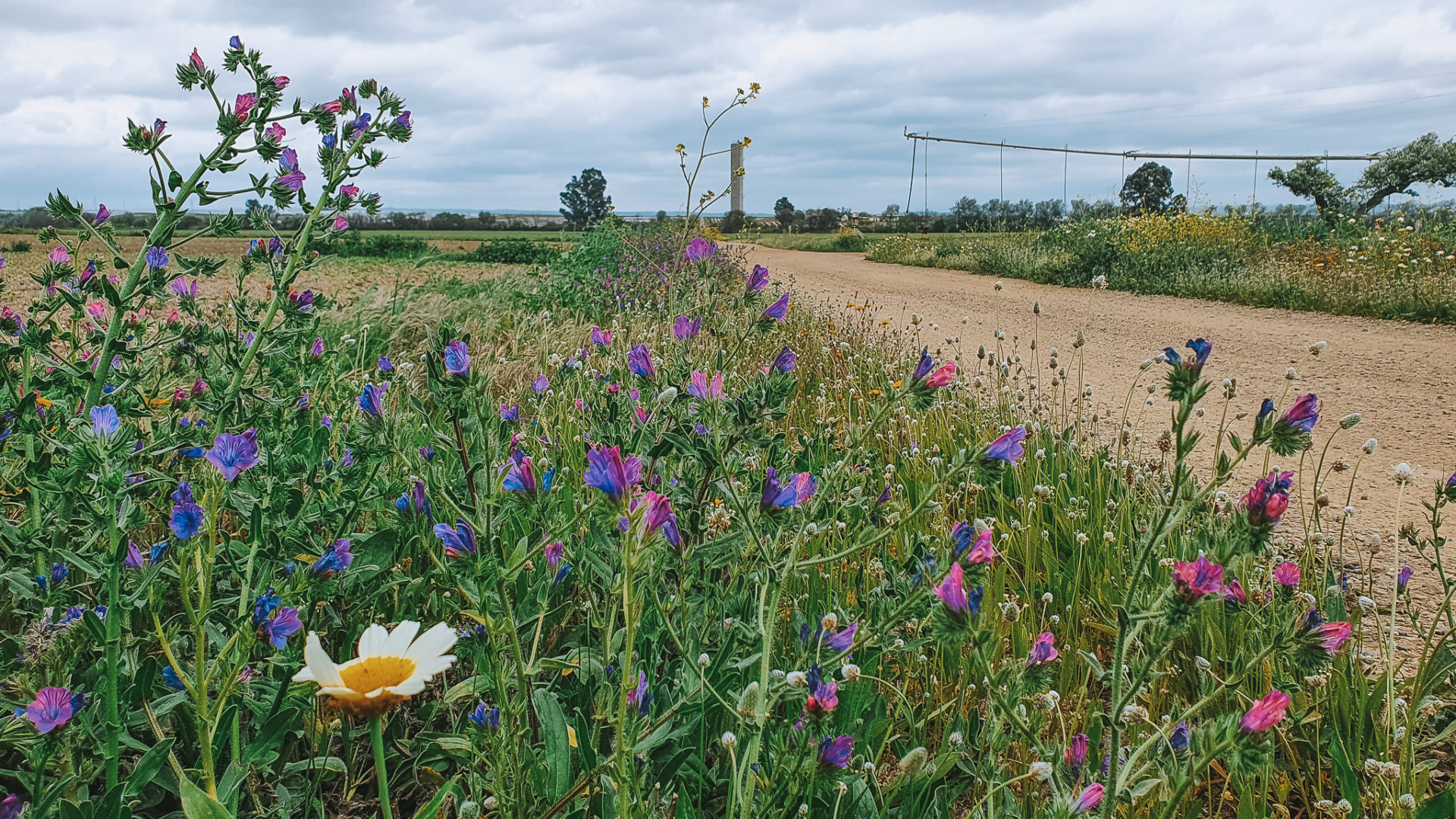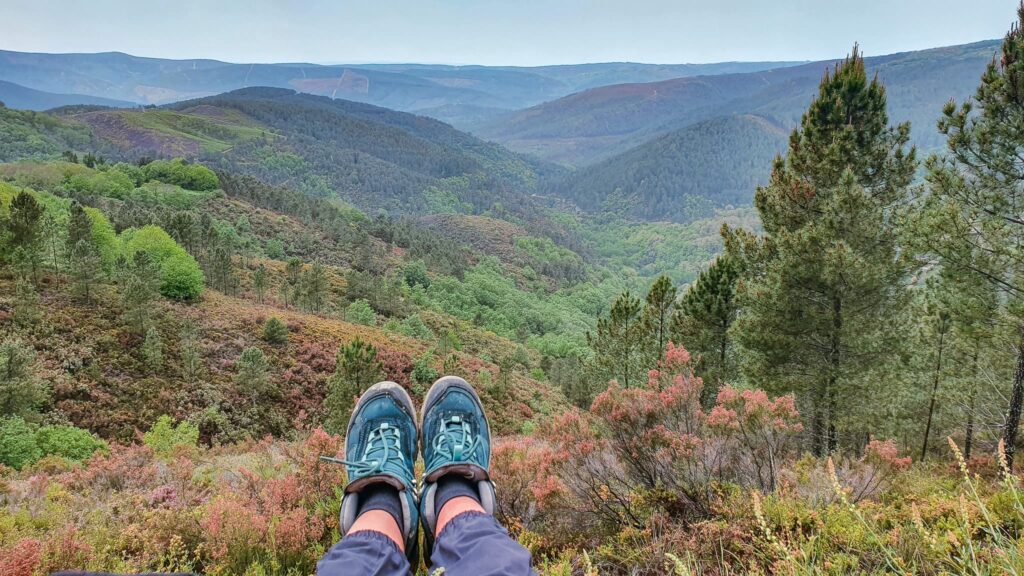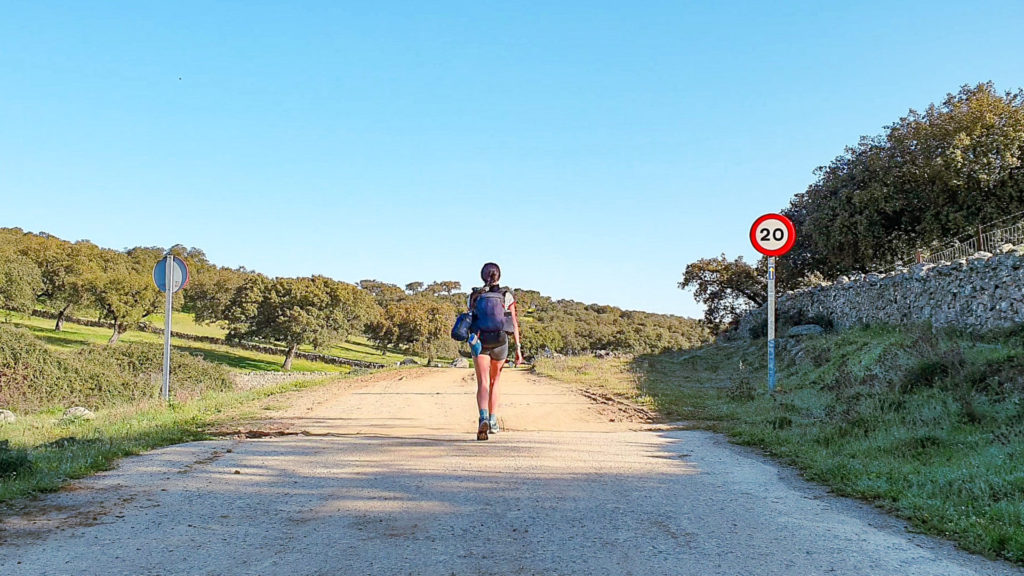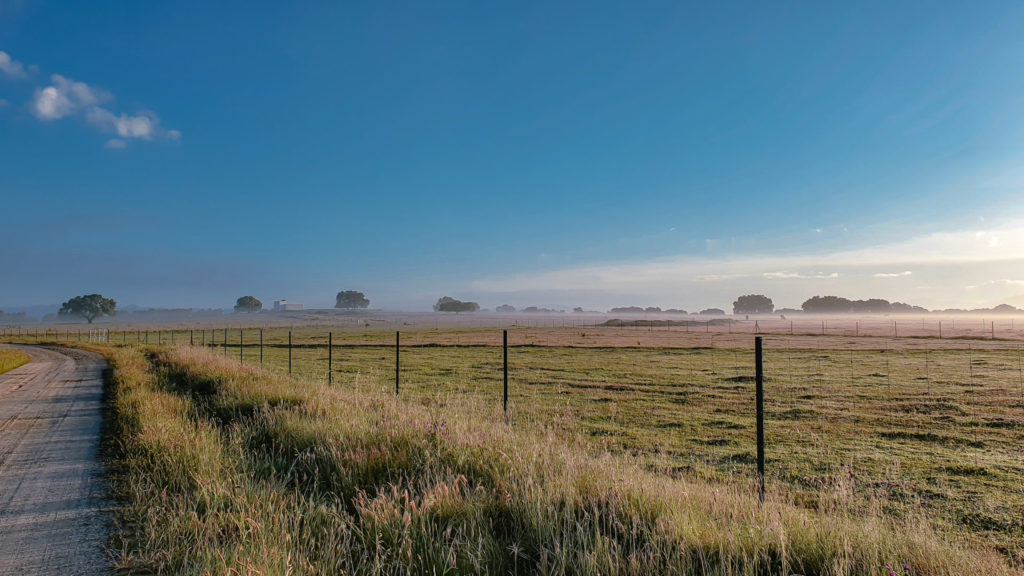If you ever thought about walking the Via de la Plata, you may get some insights into this wonderful experience by reading this post about my experience on this Camino. This is the first part of the Via de la Plata, from Sevilla to Mérida.
- About Via de la Plata
- Getting ready for the Via de la Plata
- Stage 1: Sevilla to Guillena
- Stage 2: Guillena to Castilblanco de los Arroyos
- Stage 3: Castilblanco de los Arroyos to Almadén de la Plata
- Stage 4: Almadén de la Plata to Monesterio
- Stage 5: Monesterio to Fuente de Cantos
- Stage 6: Fuente de Cantos to Zafra
- Stage 7: Zafra to Villafranca de los Barros
- Stage 8: Villafranca de los Barros to Torremejía
- Stage 9: Torremejía to Mérida
When I started walking the Via de la Plata in Sevilla, I wanted to keep a daily journal of my experience on this blog. I soon realized how hard that was. Not only did I get to the end of the day tired and only wishing I could get in bed as soon as possible, but there was always something happening. From meeting new people and going out for dinner or drinks to dealing with the inevitable ailments, every day was a new adventure.
So after keeping this journal for roughly ten days, I decided to give up and just enjoy the experience and write about it at a later time. I did keep handwritten notes of every stage, with costs, accommodation options, and my personal experiences. I’ll try to bring that all together in a few articles, divided based on the main sections of this Camino.
Enjoy reading about my misadventures! I hope they will help you in your experience of walking the Via de la Plata.
About Via de la Plata
There are many established Camino de Santiago Routes, although the most famous one is the Camino Frances or French Way. Starting from Saint-Jean-Pied-de-Port, the Camino is nearly 800 kilometers long and it crosses the north of Spain, passing through cities like Pamplona, Burgos, and Leon.
The Via de la Plata, or Silver Route, starts in Sevilla and is one of the longest Caminos in Spain at roughly 1000 kilometers. The route crosses Spain from south to north, from Andalucia to Galicia, passing through Extremadura and Castilla y León. With stops in Mérida, Cáceres, and Zamora, the Via de la Plata follows an old Roman way to merge into either the French Way or the Camino Sanabrés.
Although it’s an unusual choice for a first Camino, I decided to walk the Via de la Plata mainly because I knew it was one of the least crowded Caminos. It is also a challenging way, with long stages and fewer intermediate stops. It is, however, mostly flat for the greatest part, which makes it easier in a way. Check out my other article if you want to know more about the Via de la Plata stages.
Late spring and autumn are the most popular times to walk the Via de la Plata. Summer is basically out of the picture due to extremely high temperatures. I figured mid-April would be a great time to start walking, so I could reach Santiago de Compostela at the end of May.
I arrived in Sevilla on the evening of Palm Sunday, which meant huge crowds all over the historical center. It was weird seeing so many people on the streets, something I hadn’t experienced much in the past few years. But the weather was great, sunny and moderately warm. I kinda wished I had more time to explore this beautiful city. I did manage to go for a short walk around the city center.
Getting ready for the Via de la Plata
You could spend weeks preparing for walking the Via de la Plata, but one thing is certain: there will always be unexpected situations. So do plan, but keep an open mind and be flexible. I am a planner, and I soon realized this is not something you plan. This is something you experience.
That being said, there are a couple of mandatory requirements for any Camino. Having a backpack with all the necessary items but at the same time not too many, and having the credencial del peregrino. The latter is an important document, not only to get the “Compostela” at the end of the Camino but also to be able to sleep in the albergues, which are usually reserved for pilgrims.
At every stage, you can get a stamp on the credencial, called “sello”. These are important to prove how long you walked and to obtain the Compostela. But they will also become the milestones that mark your progress. You’ll be excited for each new sello (stamp) you get on your credencial, as it marks yet another completed stage.
Other than these two things, you may want to keep some sort of guide of the Camino, be it a physical one or a digital one. If you’re asking me, a digital one is better. An app takes no space in your backpack, and you will soon realize how much every gram counts. For more practical information, check out my article on how to plan for Via de la Plata.
Now let’s get into it. Here is a stage-by-stage breakdown of my Via de la Plata, from Sevilla to Merida.
Stage 1: Sevilla to Guillena
The first stage of the Via de la Plata starts in Sevilla and ideally ends in Guillena. On Monday morning, April 11th, I had a late start because I had to wait for stores to open and buy a SIM card that I only decided to buy the night before.
Before departing, I wanted to get my stamp from the Catedral de Sevilla, which took longer than expected. The stamps got unexpectedly misplaced, so I had to wait for the only person who still had one, the guardian who was doing the rounds. After half an hour admiring the high ceilings and colored glasses of the cathedral, I finally got my sello and was on my way to Triana, a district in Sevilla on the other side of the river. There, after a few more unexpected issues and checking three different stores, I finally got my SIM card and was ready to start walking.

The road to Guillena was mostly flat and easy. Parts of the way were alongside the main road, which is not ideal, but not much of an issue. After following the river for a while, I walked the well-signaled road through the fields leading to Santiponce, an intermediate stop. I stopped for coffee, got another sello at Bar El Barranco, and explored the town a little bit. The Roman theater in Santiponce was unfortunately closed. On the bright side, the entire town was filled with the smell of blooming orange trees.
From Santiponce, after a bit of walking on the side of the road, a long dirt road stretched in front of me, cutting through green fields. I didn’t cross anyone the entire way from Sevilla to Guillena, which made me wonder whether I would meet other pilgrims.

Shortly before 4 pm, after roughly 23 kilometers, I finally arrived in Guillena, only to discover the Albergue municipal was closed. I then made my way to Albergue Luz del Camino, where I got a bed with breakfast included for 14€. The albergue was nice, there were quite a few other pilgrims, and I was lucky to only share a room with two other girls. We went for dinner at Bar Francés, which had a pilgrim’s menu for 7€ and served dinner before the usual Spanish time.
It was a slow but nice start to the Camino. Unfortunately, the second day, the forecast showed rain all day long. Nevertheless, I was excited to keep walking.
Stage 2: Guillena to Castilblanco de los Arroyos
Despite the forecast predicting a full day of rain, we started walking with relatively clear skies. After leaving Guillena behind, we took a muddy dirt road that made it a bit difficult to walk. We had a good couple of rain-free hours before it started drizzling. Fortunately, it didn’t last long, and after a while the sun came out.

The downside of this stage, despite it being relatively short (19 km), is that there are no intermediate stops. Because of the unstable weather, we kept walking without any breaks, except for drinking water or grabbing a snack from our backpacks. I walked with another girl I met in Guillena, a nice change from the solitude of the first day. Towards the end of the trail, my feet started to hurt. We luckily made it to Castilblanco de los Arroyos just in time before it started raining again. The albergue municipal in Castilblanco was big and donation-based.

When I finally removed my shoes, I noticed a blood-filled blister on the side of my right big toe. I guess this was bound to happen. The bright side was that we arrived at 1.30 PM, so I could spend a decent amount of time without shoes.

The town was nice and quiet. The supermarket was a short walk from the albergue. Luckily, the rain stopped long enough for me to walk there in my sandals without getting my feet wet. You could hear birds singing all over town, and the fresh air after the rain felt oh so nice. Despite the pain in my feet, I was enjoying this Camino so far.
Stage 3: Castilblanco de los Arroyos to Almadén de la Plata
The day started well, with a relatively early start at 8 AM. The downside of the first 15 km was that we had to walk on the side of the road, with cars passing by. The bright side was that after 2 hours I could change to my sandals to give my aching feet a rest. Walking on the tarmac with sandals is still doable. My known blister didn’t bother me much, but I later realized I had blisters also all over my little toes, which started hurting after less than one hour of walking.

After 15 km, the Via de la Plata continued through the Sierra Norte Natural Park. A wide dirt trail passes through a beautiful and constantly changing landscape, at first with short trees and a lot of grass, later on with tall trees with deep green leaves. When I reached 18 km, I decided to stop for lunch, a little after noon. I lay in the grass while eating my sandwich, then bandaged my little toes to continue the walk in my hiking boots.

The second half was beautiful and painful at the same time. I came across a fox that ran away at the sight of my walking pole, which I took out of my backpack just for safety. Further ahead, I could hear woodpeckers knocking on trees and birds all around. The weather was perfect, sunny but not too warm. It was a peaceful walk. Until the very last bit, when a steep climb and a consequent descent took all the remaining strength in my feet. I wasn’t very tired, but my feet were killing me.

From the moment I entered Almadén de la Plata and until I reached the albergue, I felt the time stretch to infinity. I thought I would never reach my destination. But after a few more painful minutes, I made it, 10 minutes after 4 pm. I ended up walking 27 km instead of the expected 28, which felt like a relief since I didn’t think I could manage one more km.
Note: Later in my Camino, I realized my phone was not counting kilometers properly, so it was always showing one or two kilometers less than the actual stage.

The albergue was open and one could enter freely and take any bed. I called the hospitalera, who mentioned she was going to pass by around 8 pm. After a much-needed shower, I gathered all my forces to walk to the supermarket with another fellow pilgrim and buy some food. We made pasta and I devoured two plates of it.

The day was definitely challenging. The next stage could either be done all in one day (around 33 km) or divided into two shorter stages. I thought I would decide as I walked.
Stage 4: Almadén de la Plata to Monesterio
I knew it was going to be a long day, so I went out just as the sun was rising to get my coffee before the walk. The town was still sleeping, and only we pilgrims and a couple of locals wandered the streets. My feet were still hurting, but somehow, after my coffee, the pain subsided, and I was able to go at a steady pace for a good while.

I spent the first couple of hours walking through Sierra Norte, opening and closing gates as I went by. I walked by pastures with cows, goats, and sheep, a few playful dogs, cats, and even horses. The sky was blue with no clouds, and it was a chilly but beautiful morning.

My feet started to hurt again as I approached the first stage, El Real de la Jara, after 13 km. I stopped at a cafe for a sandwich with Jamón ibérico and another coffee and changed to my sandals. After a relatively long break, I decided to keep walking towards Monesterio, 20 km more.

The beginning was quite okay. The swap to the sandals gave my toes some relief, and I felt good walking. However, after a while, I felt like my soles and ankles needed some support, so I put my hiking boots back on. They suddenly felt two sizes smaller. I barely walked 300 meters when I saw a tiny little stream cross the path and felt the sudden urge to dip my feet. I removed my shoes and socks and enjoyed the freshness of the water on my aching feet. There was no chance of wearing my walking boots again. After a while, in an attempt to get some extra support for my ankles and soles, I wore my socks with my flip-flop-style sandals, a debatable but necessary fashion choice.

Halfway through the second stage, I stopped at a huge complex with restaurants, bars, a hotel, and a gas station just off the highway. I made my entrance into a full restaurant wearing my sandals with socks and ordered an orange juice.
The last part was the hardest. Add to the aching feet a small but steady climb for roughly 8 km all the way to Monesterio. I kept telling myself I was almost there and that I chose to do this and I could do it and any other type of encouragement and motivational speech I could think of. I had read that this walk would challenge not just your body but your mind. During this stage, I found out how true this was. Long, solitary walks are mentally challenging. An aching body doesn’t help either.

After a last, relatively steep climb, I could finally see Monesterio in the distance. And after an endless walk along the town streets at the slowest pace ever, to my disbelief, I made it to the albergue. The hospitalera took my credencial to put the stamp and saw my last one was from Almadén de la Plata. “Campeona!” she said. You walked all the way from Almadén de la Plata!? I nodded, still not fully aware I had made it. Then she added that this stage is also called “el rompe pies” which means the feet breaker, because it’s all uphill. I couldn’t agree more.

On a bright note, I got an individual room for the night, something I didn’t expect in an albergue municipal. Being a woman sometimes is an advantage. After leaving my backpack, I had what felt like the best shower I’ve ever had in my entire life. I was filled with happiness, gratitude, and a little pride for making it. Campeona! Another stage had been ticked off. I had dinner with another pilgrim I had met a couple of days before, and I was done for the day.

Stage 5: Monesterio to Fuente de Cantos
I had a late start after dealing with some work-related bureaucracy. By the time I had breakfast and was ready to walk, it was already after 9 AM. My feet hurt a little less in the morning, so I was able to walk at a faster pace for the first two hours. As the sun rose and it got hotter, my feet kept swelling, and I could feel the pressure and pain intensifying. The heat didn’t help either, as the temperature rose quite early in the morning. To complete the package, my period decided to show up, alongside a few period cramps.

The landscape, however, was truly impressive. After the first hour, the trees started to be fewer and farther between, and they eventually left the place to rolling hills. Already halfway through, I could see my destination, Fuente de Cantos, in the distance. This gave me mixed feelings. On one hand, I felt relieved to be able to see where I was heading. On the other, as I kept walking in the heat, the town semmed to get further and further away. I tried to focus my attention on the hills around me, the tall grass dancing in the wind, the yellow and purple flowers that at times extended as far as the eye could see.

About 6 km before arriving in Fuente de Cantos, I gave up and decided to swap to my sandals. The decision felt good at first until I started to feel a subtle pain near my right ankle. The pain grew stronger as I kept walking, but there was no way I could wear my hiking boots again. As usual, the last half hour was the hardest. When you know you’re almost there, but every part of your body is begging you to just stop and rest, yet you want to reach your destination, so you keep pushing through.

Eventually, I made it to Fuente de Cantos and to Casa Vicenta, a restaurant that also rented rooms for pilgrims. I arrived at peak hour, 2 PM, when waiters were running around like crazy, serving tables. I managed to ask for my room and get a key. The moment I finally put my backpack down for the day was my favorite. I also got a single room, which I was grateful for because I truly needed to be by myself, rest, write, and do some work. In total, I walked 20 km but as if that wasn’t enough, I added an extra 2.5 km of going to the pharmacy and back. Who knew Fuente de Cantos was so big?

My feet were getting worse. I was still waiting for the moment when my toes somehow got used to the fact that we were in this for the long run so my blisters could just as well pop or harden, or something. I should have brought hiking sandals too. Oh well, we learn by making mistakes.
Stage 6: Fuente de Cantos to Zafra
This stage was very eventful. My feet were still sore in the morning, but I decided to start walking and see how I felt. I knew there was another small town roughly 6 km after Fuente de Cantos, so I decided it was a good idea to walk there and then decide. Luckily for me, I walked with another fellow pilgrim, who was, unluckily for him, also in pain. The first hour until Calzadilla de los Barros went pretty well. The weather was good, and after the initial pain, my feet felt better. So we decided to just keep going.

The following town, Puebla de Sancho Pérez, was roughly 14 km away, only 3 km before Zafra. Very soon after we left Calzadilla de los Barros, the temperature started to rise and it got extremely hot. My feet were burning in my shoes, and I could feel them swelling. Talking to my walking companion helped me keep my mind off the pain at times, but with every minute passing, it got worse. After climbing the umpteenth hill and still not seeing any town in the distance, I started doubting I could make it. But we eventually reached Puebla de Sancho Pérez, where we stopped for a quick lunch and a fresh drink. There, I removed my shoes only to realize my little toe had swollen to at least twice its size.

I walked the remaining 4 km to the albergue in Zafra wearing my sandals. Even so, my foot was in pain and was starting to swell even beyond my toe. At Albergue Convento San Francisco, the hospitalera that welcomed us was very friendly and joyous. It was nice to feel such a warm welcome and I felt so relieved and grateful I had made it through yet another difficult stage. In total, we walked nearly 25 km.

After the shower, we paid a visit to the pharmacy only to get directed to the Centro de Salud to see a doctor. After a quick look at my foot, he prescribed antibiotics and told me to go to a nurse who would take care of it. I got out of the emergency room with a huge bandage on my little toe and another smaller one on my big toe, on my other blister. It was now impossible to wear closed shoes, so I ventured on a new mission: buying hiking sandals. I didn’t have much luck, but managed to find something better than my rubber sandals, so I could hopefully continue walking.

Dinner at the albergue was very nice, together with other pilgrims, some that I knew and others that I had just met. Zafra is beautiful, and you could feel the festive atmosphere of the Saturday before Easter. With narrow alleys, castles, and lovely churches, the town is a little gem. Too bad I was too tired to explore it better.
Stage 7: Zafra to Villafranca de los Barros
After many days of walking in pain with my hiking shoes, I finally had a day free of pain in my new sandals. I started walking at 8.30 when it was not yet very hot. After less than one hour, I reached Los Santos de Maimona, a small town just north of Zafra. I was still feeling great, so I didn’t stop for a break. I just admired the beautiful square and church.
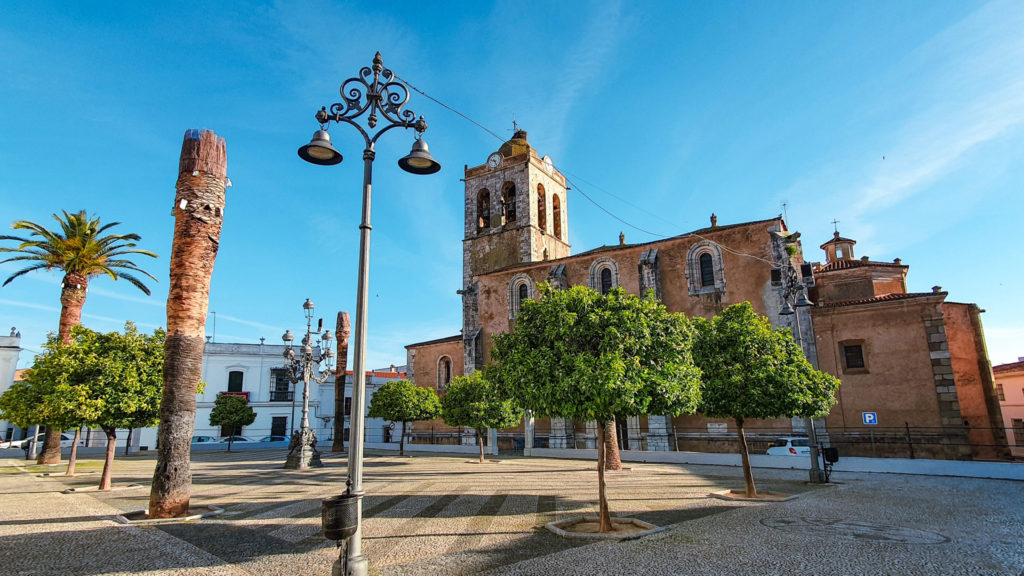
The landscape changed throughout the day, from a nice shaded area with lots of trees before Los Santos de Maimona, to huge open fields with no trees, to areas with small olive trees. I was getting used to the typical Extremadura landscape. However, the temperature rose a lot that day, and very early in the morning. By 11 AM, it was already very hot.

Villafranca de los Barros came into sight when I had around 6 or 7 km to go. It wasn’t even noon then, and I was still feeling okay walking in my sandals. I reached the Albergue at 12.45, sweaty but free of pain in my feet. I even had time to enjoy the town, catch up on work, and chat with some other pilgrims. It was a good day. My foot was slowly getting better, and I could feel my legs and back getting stronger. I really needed a short stage to rest a bit. It was less than 19 km from Zafra to Villafranca de los Barros, the perfect amount to make some progress without getting too tired.

Villafranca de los Barros is a quaint town, although a little unusual. Because it was Easter Sunday, almost everything was closed, from supermarkets to most restaurants. But we were staying in a lovely albergue right next to the main church, Iglesia de Santa María del Valle. Overall, it was a very good day.
Stage 8: Villafranca de los Barros to Torremejía
I expected the day to be a tough day so I decided to have an earlier start. After an early breakfast, I left Villafranca de los Barros at 8 AM, ready for a long walk with nothing but olive trees, dirt roads, and sun. After a couple of hours, a straight road extended in front of me with seemingly no end in sight. The small olive trees provided no shade, except for the occasional taller one you could sit under.

The stage was quite long, over 25 km, with no other village to stop for a break. More than physically challenging, this was a mentally tough stage. Walking in a straight line without seeing the end can get boring pretty fast. On that day, more than ever, I felt the weight of the backpack on my back. Luckily, my foot was better in the sandals.

For a brief couple of minutes, as I climbed a hill, I could see Torremejía in the distance, but it soon disappeared from sight. I walked most of the stage alone, until noon, when I met another pilgrim and we stopped for lunch. A light breeze and some shade from the olive tree were much needed.

The last 7 km went faster and we finally arrived into Torremejía around 2 PM. Albergue Roja Plata was small and we were all staying in the same room, not very big but filled with bunk beds. I expected it to be an interesting night.
Stage 9: Torremejía to Mérida
Finally, an easy day. Despite a relatively late start around 8.30 AM, we arrived in Mérida before noon. The walk was pleasant for most of the time, except for a little part along the main road. After that, the path took us through a lovely area with lots of trees, colorful flowers, and birds flying peacefully above us.

After a chilly morning, the temperature rose just a little, so it was still comfortable to walk with long pants and a long-sleeved shirt. I enjoyed another day walking in company, which made the time fly. After a tough stage the previous day, this was just what I needed. My feet were feeling much better, and I didn’t feel the weight of the backpack so much.

To enter Mérida, we passed the old Roman bridge, one of the many testimonials from the time when the city was a Roman colony. I was happy to have a rest day there and enjoy the city before continuing the Camino.

Mérida was the first big milestone. I spent two days exploring the city, spending time with other pilgrims, and catching up on work. Little did I know how the next few stages would challenge my mind and body. But more on that soon in the next part of this adventure.
That’s about it for the first part of Via de la Plata, from Sevilla to Mérida. Below you can find the other three parts:
- Via de la Plata Part 2: Mérida to Salamanca
- Via de la Plata Part 3: Salamanca to Ourense
- Via de la Plata Part 4: Ourense to Santiago
Do you have any funny, tragic, or inspiring stories about this part of the Via de la Plata? Share them in the comments section!
Buen Camino!

